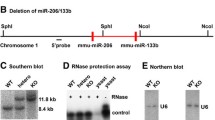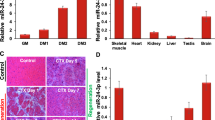Abstract
The present study investigated the function of miR-1 and miR-133a during the postnatal development of mouse skeletal muscles. The amounts of miR-1 and miR-133a were measured in mouse masseter and gastrocnemius muscles between 1 and 12 weeks after birth with real-time polymerase chain reaction and those of HDACs, MEF2, MyoD family, MCK, SRF, and Cyclin D1 were measured at 2 and 12 weeks with Western blotting. In both the masseter and gastrocnemius muscles, the amount of miR-1 increased between 1 and 12 weeks, whereas the amount of HADC4 decreased between 2 and 12 weeks. In the masseter muscle, those of MEF2, MyoD, Myogenin, and MCK increased between 2 and 12 weeks, whereas, in the gastrocnemius muscle, only those of MRF4 and MCK increased. The extent of these changes in the masseter muscle was greater than that in the gastrocnemius muscle. The amounts of miR-133a, SRF, and Cyclin D1 did not change significantly in the masseter muscle between 1 and 12 weeks after birth. By contrast, in the gastrocnemius muscle, the amounts of miR-133a and Cyclin D1 increased, whereas that of SRF decreased. Our findings suggest that the regulatory pathway of miR-1 via HDAC4 and MEF2 plays a more prominent role during postnatal development in the masseter muscle than in the gastrocnemius muscle, whereas that of miR-133a via SRF plays a more prominent role in the gastrocnemius muscle than in the masseter muscle.









Similar content being viewed by others
References
Jackson RJ, Standart N (2007) How do microRNAs regulate gene expression? Sci STKE 367:1–13. doi:10.1126/stke.3672007re1
Bushati N, Cohen SM (2007) microRNA functions. Annu Rev Cell Dev Biol 23:175–205. doi:10.1146/annurev.cellbio.23.090506.123406
Stefani G, Slack FJ (2008) Small non-coding RNAs in animal development. Nat Rev Mol Cell Biol 9:219–230. doi:10.1038/nrm2347
Kloosterman WP, Plasterk RH (2006) The diverse functions of microRNAs in animal development and disease. Dev Cell 11:441–450. doi:10.1016/j.devcel.2006.09.009
McCarthy JJ (2008) MicroRNA-206: the skeletal muscle-specific myomiR. Biochim Biophys Acta 1779:682–691. doi:10.1016/j.bbagrm.2008.03.001
Chen JF, Mandel EM, Thomson JM, Wu Q, Callis TE, Hammond SM, Conlon FL, Wang DZ (2006) The role of microRNA-1 and microRNA-133 in skeletal muscle proliferation and differentiation. Nat Genet 38:228–233. doi:10.1038/ng1725
Liu N, Williams AH, Kim Y, McAnally J, Bezprozvannaya S, Sutherland LB, Richardson JA, Bassel-Duby R, Olson EN (2007) An intragenic MEF2-dependent enhancer directs muscle-specific expression of microRNAs 1 and 133. Proc Natl Acad Sci USA 104:20844–20849. doi:10.1073/pnas.0710558105
Zhao Y, Samal E, Srivastava D (2005) Serum response factor regulates a muscle-specific microRNA that targets Hand2 during cardiogenesis. Nature 436:214–220. doi:10.1038/nature03817
Rao PK, Kumar RM, Farkhondeh M, Baskerville S, Lodish HF (2006) Myogenic factors that regulate expression of muscle-specific microRNAs. Proc Natl Acad Sci USA 103:8721–8726. doi:10.1073/pnas.0602831103
Chen JF, Callis TE, Wang DZ (2009) microRNAs and muscle disorders. J Cell Sci 122:13–20. doi:10.1242/jcs.041723
Callis TE, Deng Z, Chen JF, Wang DZ (2008) Muscling through the microRNA world. Exp Biol Med (Maywood) 233:131–138. doi:10.3181/0709-MR-237
Townley-Tilson WH, Callis TE, Wang D (2010) MicroRNAs 1, 133, and 206: critical factors of skeletal and cardiac muscle development, function, and disease. Int J Biochem Cell Biol 42:1252–1255. doi:10.1016/j.biocel.2009.03.002
Zhang H, Fu Y, Su Y, Shi Z, Zhang J (2015) Identification and expression of HDAC4 targeted by miR-1 and miR-133a during early development in Paralichthys olivaceus. Comp Biochem Physiol B Biochem Mol Biol 179:1–8. doi:10.1016/j.cbpb.2014.08.005
Latronico MV, Catalucci D, Condorelli G (2007) Emerging role of microRNAs in cardiovascular biology. Circ Res 101:1225–1236. doi:10.1161/CIRCRESAHA.107.163147
Liu N, Olson EN (2010) MicroRNA regulatory networks in cardiovascular development. Dev Cell 18:510–525. doi:10.1016/j.devcel.2010.03.010
Deng Z, Chen JF, Wang DZ (2011) Transgenic overexpression of miR-133a in skeletal muscle. BMC Musculoskelet Disord 12:115. doi:10.1186/1471-2474-12-115
Torella D, Iaconetti C, Catalucci D, Ellison GM, Leone A, Waring CD, Bochicchio A, Vicinanza C, Aquila I, Curcio A, Condorelli G, Indolfi C (2011) MicroRNA-133 controls vascular smooth muscle cell phenotypic switch in vitro and vascular remodeling in vivo. Circ Res 109:880–893. doi:10.1161/CIRCRESAHA.111.240150
Gao S, Wassler M, Zhang L, Li Y, Wang J, Zhang Y, Shelat H, Williams J, Geng YJ (2014) MicroRNA-133a regulates insulin-like growth factor-1 receptor expression and vascular smooth muscle cell proliferation in murine atherosclerosis. Atherosclerosis 232:171–179. doi:10.1016/j.atherosclerosis.2013.11.029
Yamane A (2005) Embryonic and postnatal development of masticatory and tongue muscles. Cell Tissue Res 322:183–189. doi:10.1007/s00441-005-0019-x
Yamane A, Ohnuki Y, Saeki Y (2000) Delayed embryonic development of mouse masseter muscle correlates with delayed MyoD family expression. J Dent Res 79:1933–1936. doi:10.1177/00220345000790120201
Yamane A, Mayo M, Shuler C, Crowe D, Ohnuki Y, Dalrymple K, Saeki Y (2000) Expression of myogenic regulatory factors during the development of mouse tongue striated muscle. Arch Oral Biol 45:71–78. doi:10.1016/S0003-9969(99)00105-3
Yamane A, Saito T, Nakagawa Y, Ohnuki Y, Saeki Y (2002) Changes in mRNA expression of nicotinic acetylcholine receptor subunits during embryonic development of mouse masseter muscle. Zool Sci 19:207–213
Nariyama M, Kota Y, Kaneko S, Asada Y, Yamane A (2012) Association between the lack of teeth and the expression of myosins in masticatory muscles of microphthalmic mouse. Cell Biochem Funct 30:82–88. doi:10.1002/cbf.1821
Ludolph DC, Konieczny SF (1995) Transcription factor families: muscling in on the myogenic program. FASEB J 9:1595–1604
Lewis A, Riddoch-Contreras J, Natanek SA, Donaldson A, Man WD, Moxham J, Hopkinson NS, Polkey MI, Kemp PR (2012) Downregulation of the serum response factor/miR-1 axis in the quadriceps of patients with COPD. Thorax 67:26–34. doi:10.1136/thoraxjnl-2011-200309
Gallagher IJ, Scheele C, Keller P, Nielsen AR, Remenyi J, Fischer CP, Roder K, Babraj J, Wahlestedt C, Hutvagner G, Pedersen BK, Timmons JA (2010) Integration of microRNA changes in vivo identifies novel molecular features of muscle insulin resistance in type 2 diabetes. Genome Med 2:9. doi:10.1186/gm130
Al-Khalili L, Chibalin AV, Yu M, Sjödin B, Nylén C, Zierath JR, Krook A (2004) MEF2 activation in differentiated primary human skeletal muscle cultures requires coordinated involvement of parallel pathways. Am J Physiol Cell Physiol 286:1410–1416. doi:10.1152/ajpcell.00444.2003
Dokmanovic M, Clarke C, Marks PA (2007) Histone deacetylase inhibitors: overview and perspectives. Mol Cancer Res 5:981–989. doi:10.1158/1541-7786.MCR-07-0324
McGee SL, Hargreaves M (2011) Histone modifications and exercise adaptations. J Appl Physiol 110:258–263. doi:10.1152/japplphysiol.00979.2010
Miska EA, Langley E, Wolf D, Karlsson C, Pines J, Kouzarides T (2001) Differential localization of HDAC4 orchestrates muscle differentiation. Nucl Acids Res 29:3439–3447. doi:10.1093/nar/29.16.3439
McKinsey TA, Zhang CL, Lu J, Olson EN (2000) Signal-dependent nuclear export of a histone deacetylase regulates muscle differentiation. Nature 408:106–111. doi:10.1038/35040593
Lu J, McKinsey TA, Zhang CL, Olson EN (2000) Regulation of skeletal myogenesis by association of the MEF2 transcription factor with class II histone deacetylases. Mol Cell 6:233–244. doi:10.1016/S1097-2765(00)00025-3
Dodou E, Xu SM, Black BL (2003) mef2c is activated directly by myogenic basic helix-loop-helix proteins during skeletal muscle development in vivo. Mech Dev 120:1021–1032. doi:10.1016/S0925-4773(03)00178-3
Ivey KN, Muth A, Arnold J, King FW, Yeh RF, Fish JE, Hsiao EC, Schwartz RJ, Conklin BR, Bernstein HS, Srivastava D (2008) MicroRNA regulation of cell lineages in mouse and human embryonic stem cells. Cell Stem Cell 2:219–229. doi:10.1016/j.stem.2008.01.016
Xie C, Huang H, Sun X, Guo Y, Hamblin M, Ritchie RP, Garcia-Barrio MT, Zhang J, Chen YE (2011) MicroRNA-1 regulates smooth muscle cell differentiation by repressing Kruppel-like factor 4. Stem Cell Dev 20:205–210. doi:10.1089/scd.2010.0283
Callis TE, Chen JF, Wang DZ (2007) MicroRNAs in skeletal and cardiac muscle development. DNA Cell Biol 26:219–225. doi:10.1089/dna.2006.0556
Acknowledgments
This study was supported by JSPS KAKENHI Grant Number 24792313 (MN), 20592190, 25463201 (AY), and 23593053 (YA). We thank Dr. Jim Cahill of ON-LINE EDIT Science Communications for help in the preparation of this manuscript.
Author information
Authors and Affiliations
Corresponding author
Rights and permissions
About this article
Cite this article
Nariyama, M., Mori, M., Shimazaki, E. et al. Functions of miR-1 and miR-133a during the postnatal development of masseter and gastrocnemius muscles. Mol Cell Biochem 407, 17–27 (2015). https://doi.org/10.1007/s11010-015-2450-y
Received:
Accepted:
Published:
Issue Date:
DOI: https://doi.org/10.1007/s11010-015-2450-y




